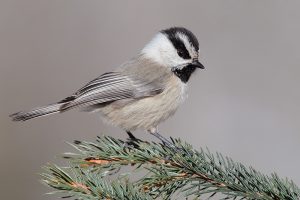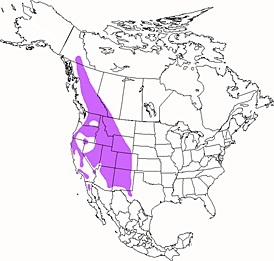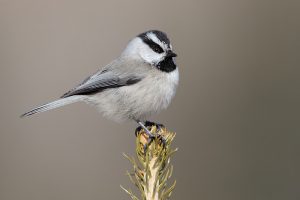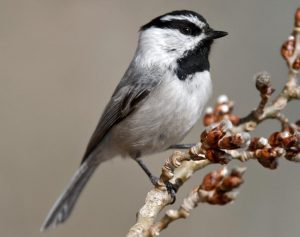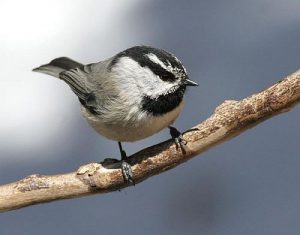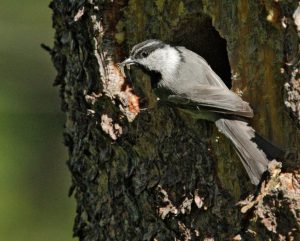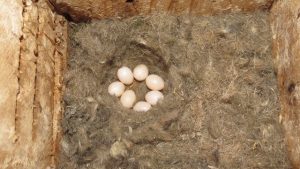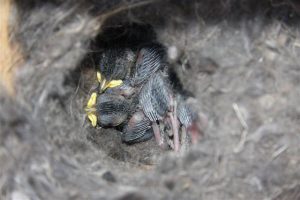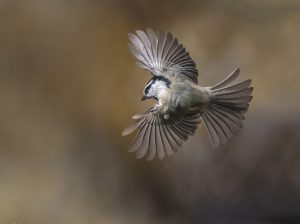Mountain Chickadee
Mountain Chickadees are small, stockily-built passerine songbirds with short and strong beaks.
Scientific Classification
| Kingdom | Animalia |
| Phylum | Chordata |
| Class | Aves |
| Order | Passeriformes |
| Family | Paridae |
| Genus | Poecile |
| Species | Poecile gambeli |
Quick Information
| Similar Species | Black-capped Chickadee, Boreal Chickadee, Chestnut-backed Chickadee |
| Other Names | Mésange de Gambel (French),Carbonero ceja blanca (Spanish) |
| Size | 13-15 cm (5-6 in) |
| Wingspan | Around 19 cm (7.5 in) |
| Weight | Around 11 g (0.4 oz) |
| Color | Pale gray with white cheeks, black throat, and crown; white eyebrows, pale gray flanks, gray wings and tail, grayish-black legs and feet, a white line over each eye; males, females, and young birds have similar plumage |
| Distribution | British Columbia, the Rocky Mountains, the cascade and the Sierra Nevada ranges, Southern California, Arizona, New Mexico and Texas |
| Habitat | Mountain forests, conifers and mixed woodlands at levels above 10,000 feet. They are generally non-migratory but, in winter when the food is scarce, these birds are forced to move to lower altitude and can be spotted at sea level, desert oasis, open woodlands and in riparian areas. |
| Nesting | Mid-June to late July |
| Sounds | Call: A hoarse chick – adee-dee-dee, a variety of buzzes and chipsSong: 3 or 4 note descending whistle fee-bee-bay or fee-bee-fee-bee |
| Lifespan | Around 8 to 10 years |
| Diet | Feeds on insects including beetles, caterpillars, and spiders; also eats insect eggs and pupae; seeds, berries, and small fruits |
| Adaptations | An insulating layer of soft feathers protects it from cold weather, its waterproof contour feathers make it resistant to water |
| Clutch Size | 7-9 eggs |
| Egg Size (approx) | Around 1.6 cm (0.6 inch) |
| Number of Broods | 1-2 |
| Incubation Period | Around 14 days |
| Predation and Competition | Hawks, owls and shrikes |
| IUCN Conservation Status | Least Concern |
Behavior
These active foragers are insect gleaners and are also known to be very acrobatic, agile, and tree-loving. They often hang upside down to reach out to the underside of the branches, cones, and needles. They store food during the fall season and bank on those during winter when resources are usually scarce. They began to split into pairs during spring and in winter they flock with mixed-species birds.
Breeding and Nesting
They are monogamous in nature, and usually, bonds are long-term. They stick to their own territories during the breeding season.
Mountain Chickadees use tree cavities as their nesting sites. They also dig their own holes in rotten or soft wood. Both male and female take an active part in building the nest, which are made of moss, lichen, grasses and are lined with hair or fur.
Lifecycle
The male gathers food and feeds the female while she incubates the eggs. As the young birds emerge from their shells and start growing, the female joins the male in gathering food. Fledging takes place at about eighteen to twenty-one days, after which the young birds are ready to leave the nest. However, they remain under the care of their parents for another two to three weeks.
Interesting Facts
- Mountain Chickadees are referred to as Alzheimer’s birds because their call sounds as if they are uttering “all-zime-hers.” Interestingly, they are known for their forgetfulness.
- According to the Energetic Models, a half-ounce Mountain Chickadee requires ten calories of food in order to survive. This amounts to one-twentieth of an ounce of peanut butter.
References:
- https://www.nps.gov/romo/learn/nature/mountain_chickadee.htm
- https://www.wasatchaudubon.org/archives/newsletter/2022-Nov-Dec-Newsletter.pdf
- https://www.nationalgeographic.com/animals/birds/facts/mountain-chickadee
- http://www.audubon.org/field-guide/bird/mountain-chickadee
- https://en.wikipedia.org/wiki/Mountain_chickadee
Published on June 10th 2016 by Sajal Datta under Coniferous Forest Animals.
Article was last reviewed on 17th July 2023.


